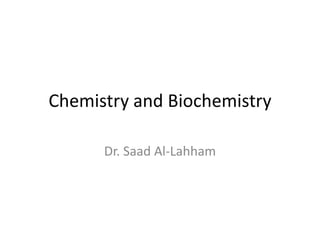
Chemistry and biochemistry l 1+2
- 1. Chemistry and Biochemistry Dr. Saad Al-Lahham
- 2. Chemistry • The science of the composition and structure of materials and the changes that materials undergo. The biosphere Ecosystems Tissues Organs and organ systems Communities Populations Organisms Organelles Cells Atoms Molecules
- 3. Atomic Theory of Matter (John Dalton) • All matter is composed of atoms, which retains its identity during chemical reaction. • An element is a type of matter composed of only one kind of atom, each atom of a given kind having the same properties (e.g. mass). • A compound is a type of matter composed of atoms of two or more elements combined in fixed proportions. • a chemical reaction consists of the rearrangement of the atoms present in the reacting substances to give new chemical combinations present in the substances formed by the reaction.
- 4. Nuclear Model of the Atom All nuclei of atoms of a particular element have the same atomic number, but they may have different mass number Isotopes: same number of protons but different number of neutrons: O-16 99.759%, O-17 0,037% and O-18 0,204% useful for biomolecules labeling Atomic mass unit (dalton): a mass unit equal to exactly 1/12 the mass of C-12 relative. (1,993X10-26/12= 1,6605402X10-27 Kg). Atomic weight: is the average atomic mass for the naturally occurring element, expressed in atomic mass units. The sum of Isotopic massesX corresbonding fractional abundances 11 Na 22,989768 Atomic Number Atomic weight+ P N Atomic number P=e Mass number
- 7. Mole concept • 1 mole = 6.02X1023 of anything Avogadro’s number. • Coins counting in a bank. • Mass of dozen of eggs ≠ dozen of cars. • In chemistry: 1 mole = 6.02X1023 particles = formula weight in grams • Molar mass - the mass of a single atom of an element (in amu) is numerically equal to the mass of one mole of those atoms (in grams). • Molar mass of C-12 = 6.02X1023 X 12 amu X 1,6605402X10-27 Kg/amu = 12 g
- 8. Molarity and Molality • Molarity: The number of moles of solute divided by the volume of the solution measured in liters. • Moles of solutes/L of solution • Molality: The number of moles of solute divided by the weight measured in Kg. • Molality=Moles of solutes/Kg • Mole= mass/Mwt
- 9. Calculating M • From moles and volume: – What is the molarity of a solution containing 0.32 moles of NaCl in 3.4 liters? – 0.32 mole/3,4L= 0.094 M • From Mass and Volume: – What is the molarity of a solution made by dissolving 2.5 g of NaCl in enough water to make 125 ml of solution? – Moles= mass/mwt 2,5g/58.5g/mole= 0.0427 mole – M= 0.0427 mole/ 0.125= 0.34 M • Calculating Mass of Solute from Molarity: – How would you prepare 400. ml of 1.20 M solution of sodium chloride? – Moles = V*M 0.4L*1.2 mole/L= 0.48 moles – Mass = mwt*moles 58.5*0.48 = 28.1 g
- 10. Diluting solutions • moles = M*V, but moles are equal before and after dilution • Mi*Vi=Mf*Vf • Which one is the highest concentration? • How can we make them equally concentrated without adding more atoms?
- 11. Exercises 1. A sample of 0.0256 mole of FeCl3 was dissolved in water to give 25 ml Soln? 2. What volume of 0.12M CuSO4 is required to give 0.15 mole of CuSO4? 3. How many grams of Na2Cr2O7, should be added to 50 ml flask to prepare 0.025? Given that the Mwt of Na is 23, Cr is 104 and O is 16. 4. A 4 g sugar cube (sucrose: C12H22O11) is dissolved in a 350 ml teacup filled with hot water. What is the molarity of the sugar solution? Given that Mwt of C is 12, H is 1 and O is 16. 5. How many mL of 14.8 M NH3 solution you need to prepare 100 ml of 1 M NH3? 6. How many mL of 15.8 M HNO3 solution you need to prepare 1 L of 0.12 M HNO3?
